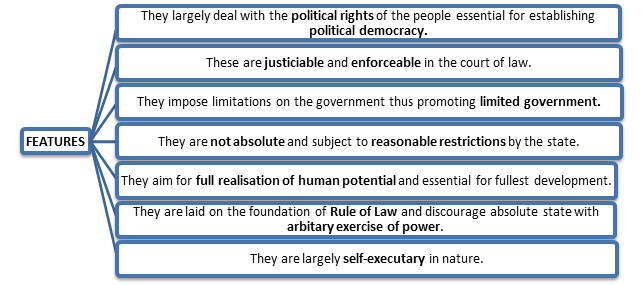Basics:
-
- Enshrined in Part III (Article 12-35) of the Constitution.
- Taken from Bill of Rights of US Constitution.
- There are 6 types of fundamental rights-

-
- Originally, there were 7 types of Fundamental Rights. Right to Property under Article 31, deleted by 44th Amendment Act 1978. It is now a legal right under Article 300A (Part XII) of the Constitution.
Features of Fundamental rights:

Fundamental rights are fundamental because:
-
- Necessary for fullest development of human being
- Based on the core ideals of democracy
- Guaranteed by the state
- Establish superiority of rights of people over state
Parliamentary Sovereignty versus Judicial Supremacy
| Parliamentary Sovereignty | Judicial Supremacy |
|---|---|
| • UK is characterized by Parliamentary Sovereignty i.e. the parliament can make any law and is supreme. Judiciary not competent to strike down a law. • The Constitution is not codified and so there is no fundamental law of law. • Legislature protects the rights of people through landmark laws, charters, statutes etc. • It lacks clear separation of power. | • US follows judicial supremacy i.e. legislature cannot take away the FRs of citizens and any such law that infringe FRs can be struck by the Supreme Court. • The constitution is written and rights codified. • Judiciary is considered supreme to protect the fundamental rights of people by interpreting the laws enacted by legislature. • It has complete separation of powers. |
India’s case
The framers of the constitution wanted to avoid both Parliamentary Sovereignty and Judicial Supremacy. Hence a balance of both was adopted such that:
Ø Fundamental rights guaranteed by the Indian Constitution are qualified.
Ø These are not absolute and the state is empowered to impose reasonable restrictions.
Ø Judiciary is considered as the guardian of Fundamental rights and can strike a law that violates these rights or considered arbitrary.
Spread the Word
